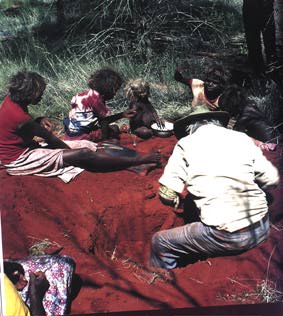NOCTURNAL DREAM AND «DREAMING»

The aboriginal have chosen themselves the term "the Dreaming" or simply «Dreaming» as the nearest equivalent to the native conceipt «alcheringa» used by the Arunta (a tribe which is located near Alice Springs in the Northern Territory or the term «jukurrpa» used by most tribes of the western and central desert, especially the Walpiri tribe.
This native concept of Dreaming (the dream with a big D) should not be confused with nocturnal dream (the dream with a small d), even if it attests by its linguistic link of a cosmology (our relationship to the universe and space-time) which gives an essential place to nocturnal dream and imagination in general. The Dream refers so, more widely, to the history in mythology and the social organisation which belongs to a perfectly oirginal culture : the one of the Australian aboriginal people.
The confusion between the term Dreaming with the dreaming experience provoked a lot of misunderstandings. Many think very often that Aboriginal are attributing a status of reality to what they see during their sleep, without making any difference with the waking state. Surely, they are not opposing the dream to reality as we do because they do not restrict it to an imaginary world but they read the nocturnal images at the research of reality signs. They interpret their dreams as a guide for daily life, to capture their ancestors¹s messages, to look and listen new rituals in the form of paintings and hymns supposed to be «forgotten» and «refound».
It is as a living memory, not only individual but also cosmologic, that the dream has its own dimension and it seems to maintain an active relation with the sensible universe. Thus, the human acts are fitting in a «philosophy» which do not state a predestination, or an eternal repetition, but the rules of different plays which make and change the individual and collective life. In this way, the Law of Dream would be the game the rules of which are not immutable but can be modified under certain limits.
 Previous page |  Back to summary |  Next page |